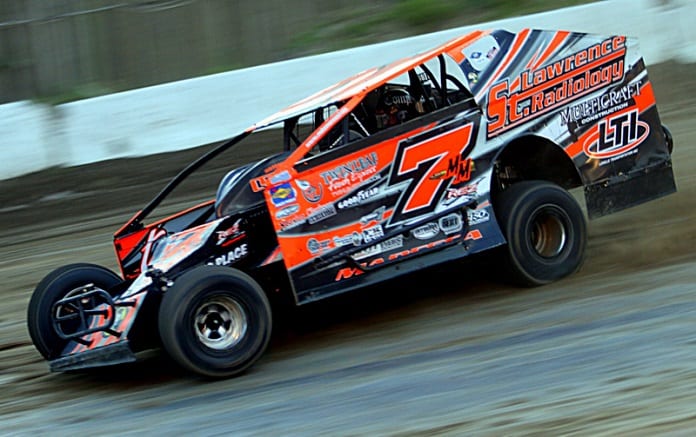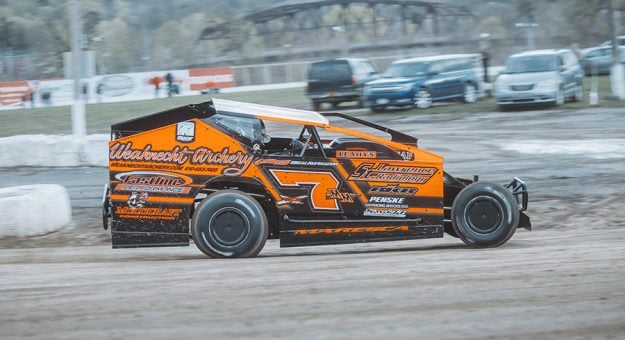FONDA, N.Y. – Dirt modifieds in the northeast have gone through many transitions over the years.
From Gary Balough, who came to the Syracuse (N.Y.) Mile in 1980 with a ground effects car, to the switch from bars to coils, and even Kenny Tremont winning in a four-link Troyer in the 90s, the game has changed numerous times.
However, no change in dirt modified racing was as quick or as drastic as the sudden change from torsion bar rear-end setups to coil-over springs in the last few years.
Then in 2019 when chassis company Teo Pro Car came out with an experimental four-link chassis, similar to the one that Tremont ran years ago and started winning with. When Anthony Perrego found success with the Teo four-link setup, it caught the eye of many within the motorsports industry.
One of those who paid attention to Perrego’s success was Mike Maresca at Fonda Speedway. When Maresca and his team unloaded their car from the trailer last Saturday, it wasn’t the No. 247 he ran last year and won the championship with, it was the No. 7mm, his own car.
The new car was a fresh DKM Fabrications four-link chassis that he wanted to test out, and the early results were promising, with a third-place finish in the Fonda season opener.
When the four-link setup was run under Tremont’s care, he won the 1999 Super Dirt Week race with it, as well as others around the region. However, technology has changed since then and Maresca believes that dirt modified racing is taking cues from late models for its current technological successes.
“I think we’re starting to pay a lot more attention to what late models are doing and the way they operate,” Maresca said. “In the 90s, I think it was a little bit different, with the way the cars rolled, the car’s attitude, shocks, springs … all that stuff is a lot different now. The cars are more up now. If you watch any normal Bicknell car, it’s up, compared to even if you watch a video from three years ago, all the cars were a lot flatter then.”
Mike Maresca
“Nowadays, late models all utilize a four-link suspension and it’s the same with IMCA and UMP (modified) cars. Even though a lot of those used to run a three-link deal, sort of similar to what the standard big-block modified uses today, it’s all continued evolving,” Maresca added. “We’re paying attention to that and realize maybe there’s some potential there.”
The way that a four-link suspension feels compared to a standard bar or coil car is also different and has required some getting used to, according to Maresca.
“The whole car is a little bit faster, reacting when you go through a hole or get on the gas; everything picks up and engages quickly,” he explained. “You have to drive it a little bit differently. You hear a lot of UMP, late model, IMCA guys talk about ‘keeping the car up on the bars’ and you really have to keep the car up on the bars. You can’t completely dump out of the gas or you might have to power brake a little bit differently to keep the car up at attitude.”
There are setup tricks to help with that goal, but ultimately, it’s the driver’s responsibility to push the car, Maresca tipped.
“When you get on the gas, the car engages and rocks up. The left rear body comes up the bars on the left side and it engages the right side, where it flattens out a little bit and the car kind of goes down on the right front, similar to a regular car, but it’s a little bit more radical,” said Maresca. “If you were to dump out of the gas, the car would kind of squat flatter. We have some things to kind of counteract that in the left rear, whether it’s compression or spring. There’s mechanical to help control it, but you still have to do a little bit with the steering wheel, the gas pedal and the brakes.”

While Maresca is able to run the four-link suspension at tracks like Fonda, Utica-Rome Speedway, Georgetown Speedway and with the Short Track Super Series, it cannot be run everywhere.
Before the 2020 season began, DIRTCar Northeast put out a rules bulletin that outlined the banning of the suspension. That decision made many wonder if such a move hurt the growth of dirt modified racing, but Maresca disagreed with those claims.
“I don’t think it hurt anything, because at the point when they did it, everybody had just started investing in the coil left side and these new Bicknell cars and the short rod bracketry and all that,” he said. “A lot of the teams spent a lot of money to switch everything over and stay relevant and racers are really stupid. Someone just starts talking about something and people automatically think, ‘Oh my God, that’s the next thing and I have to have it,’ and they remortgaged their house or what have you to buy it.”
Money is a huge thing in motorsports, and as the years have gone on, the cost to win has increased.
Maresca realizes that and even believes it may change in the future.
“Everyone just spent a ton of money to switch all their stuff over from the conventional cars that everyone had for the last 20 years to the new style, short rod, three link coil cars. I think they probably did the right thing,” he said. “I don’t think there’s a right or wrong answer; I think they probably saved some guys some money.
“(Brett) Deyo hasn’t made it illegal, so maybe in the future DIRTcar will open it up again,” Maresca continued. “I would imagine at some point, the two major sanctioning bodies will come to some sort of agreement in the future over everything. I think eventually it’ll kind of all fall into place in the next 10 years.”
When it comes to how the Fonda opener went for the No. 7mm team, they were pleased with their performance right out of the gate. But it doesn’t mean Maresca isn’t already gunning for more.
“I’d say it met my expectations,” he said. “I’ll tell you if I was a 10th-place car or if I was a first-place car. I’m not going to sit here and say, ‘I had a winning car but bad luck, blah, blah, blah, blah, blah. I’m not like that. That’s not how you get better. We tested Tuesday with this car and I told them on Wednesday or Thursday, ‘Right now I think we’re a fifth place car at Fonda during a weekly show. I think we’ve got our work cut out for us.’”
With a little bit of luck, all of Maresca and his team’s work made for a podium effort to start out his title defense.
“I started second and ran third. We had a couple little carburetor issues going on when I was getting into lapped traffic and stuff,” Maresca recalled. “I think I was maybe a tick better than Josh (Hohenforst) late in the race, but I was definitely a little bit free at the end of the race. I really freed it up a lot, probably too much. I also had some contact with a lapped car there that got me out of my rhythm a little bit.”
With the contact to the lapped car and the torque a four-link chassis puts on a frame, breaking parts could be an issue, but Maresca hasn’t been concerned about that to this point.
“I think we’ve made some really good structural improvements over the last couple of months to help. I mean, I stuffed the wall and nothing broke,” he noted. “I feel like if I would have stuffed the wall in a normal car, I probably wouldn’t have finished the race. DKM cars structurally are really built well from what I’m seeing. I’m really, really happy with what they’re putting out.
“I think they’re on par with the Bicknells and everything else.”
The four-link suspension is nothing new in the northeast, going back to when Billy Colton developed it with Troyer in the late 90s, but everything else around it has changed.
Maresca has been the latest to take a chance on the setup. Only time will tell where it goes next.
